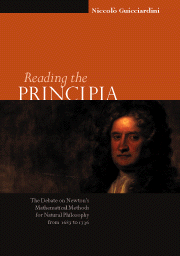 Reading the Principia
Reading the Principia Published online by Cambridge University Press: 29 March 2010
A common heritage
Despite the chauvinistic divisions originated by the Newton–Leibniz controversy, the Newtonian and the Leibnizian schools shared a common mathematical method. They adopted two algorithms, the analytical method of fluxions and the differential and integral calculus, which were translatable one into the other. As far as foundations are concerned, the situation was much more fragmented than is usually thought. The Channel did not divide the friends of infinitesimals from the adherents to limits. One finds British who refer to the infinitesimalist side of the Newtonian method (i.e. to ‘moments’) and equate moments with differentials; one finds Continentals who support a theory of limits.
Rather than seeing the Newtonians and the Leibnizians as two groups practising different mathematical methods, it is more fruitful, and more adherent to historical evidence, to focus on the amount of shared knowledge between the two schools. The British and the Continentals shared a vast quantity of common algorithmic techniques, notational devices and foundational ideas. Newton and Leibniz, however, tried, with partial success, to orient their disciples along different research lines. The difference between the Newtonians and the Leibnizians consisted in the manner in which they oriented themselves in this common mathematical heritage: it consisted in the values that they adopted, in the purposes they had in mind, and in the ways in which they placed this heritage in historical perspective.
Equivalence
Passing from the fluxional to the differential notation was a triviality.
To save this book to your Kindle, first ensure [email protected] is added to your Approved Personal Document E-mail List under your Personal Document Settings on the Manage Your Content and Devices page of your Amazon account. Then enter the ‘name’ part of your Kindle email address below. Find out more about saving to your Kindle.
Note you can select to save to either the @free.kindle.com or @kindle.com variations. ‘@free.kindle.com’ emails are free but can only be saved to your device when it is connected to wi-fi. ‘@kindle.com’ emails can be delivered even when you are not connected to wi-fi, but note that service fees apply.
Find out more about the Kindle Personal Document Service.
To save content items to your account, please confirm that you agree to abide by our usage policies. If this is the first time you use this feature, you will be asked to authorise Cambridge Core to connect with your account. Find out more about saving content to Dropbox.
To save content items to your account, please confirm that you agree to abide by our usage policies. If this is the first time you use this feature, you will be asked to authorise Cambridge Core to connect with your account. Find out more about saving content to Google Drive.